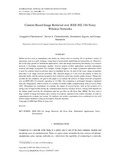| dc.description.abstract | Mobile devices such as smartphones and tablets are widely used in everyday life to perform a variety of
operations, such as e-mail exchange, connection to social media, bank/financial transactions, and so on.
Moreover, because of the large growth of multimedia applications, video and image transferring and sharing
via a wireless network is becoming increasingly popular. Several modern mobile applications perform
information retrieval and image recognition. For example, Google Goggles is an image recognition
application that is used for searches based on pictures taken by handheld devices. In most of the cases,
image recognition procedure is an image retrieval procedure. The captured images or a low-level description
of them are uploaded online, and the system recognizes their content by retrieving visually similar pictures.
Taking into account the last comment, our goal in this paper is to evaluate the process of image
retrieval/recognition over an Institute of Electrical and Electronics Engineers 802.11b network, operating
at 2.4 GHz. Our evaluation is performed through a simulated network configuration, which consists of a
number of mobile nodes communicating with an access point. Throughout our simulations, we examine the
impact of several factors, such as the existence of a strong line of sight during the communication between
wireless devices. Strong line of sight depends on the fading model used for the simulations and has an
effect on BER. We have used a large number of image descriptors and a variety of scenarios, reported in the
relative literature, in order to comprehensively evaluate our system. To reinforce our results, experiments
were conducted on two well-known images databases by using 10 descriptors from the literature. | en_UK |


